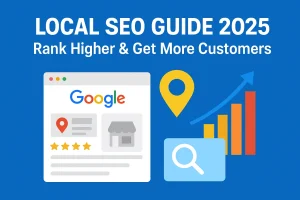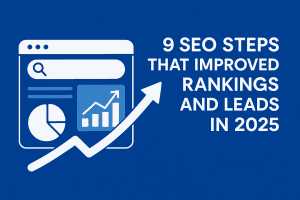1. Fix Technical Issues First
Before anything else, your site needs to be crawlable, fast, and secure. No technical foundation means no rankings — no matter how good the content is.
- Ensure the site uses HTTPS
- Fix broken links and redirect errors
- Improve load speed, especially on mobile
- Simplify navigation so all pages are reachable in three clicks or less
Case Study: In the PageSpeed Optimization project, I brought mobile load time down from 5.7 seconds to 2.1 seconds. Organic traffic rose by 14% the following month — without changing any of the content.
2. Improve Content Using E-E-A-T Principles
Google favours content written by people with real experience. I apply E-E-A-T by writing with clarity, backing claims with data, and structuring content for trust.
- Use real-world examples or client stories
- Include expert quotes and up-to-date data
- Avoid keyword stuffing or empty filler
- Add author bios and source links where relevant
Case Study: For a B2B blog, I rewrote underperforming articles to reflect the company’s actual experience and included benchmark data. The update contributed to a 111% increase in organic leads within six months.
3. Write Better Titles and Descriptions
Ranking on Google means nothing if nobody clicks. Titles and meta descriptions need to speak to real people.
- Keep titles short, clear, and under 60 characters
- Use language that reflects real search intent
- Write custom meta descriptions for every page
- Avoid gimmicks or keyword stuffing
Case Study: In the Top 10% Increase case, I rewrote the title and meta to better match search queries. CTR increased by 18% across organic impressions within four weeks.
4. Link Internally With Purpose
Internal links help Google understand your site and keep users exploring longer. I use them to connect related topics and boost underperforming pages.
- Pages that naturally relate
- Opportunities to pass link equity
- Anchor text that clearly describes what’s being linked
- Older content that can point to newer resources
Case Study: As part of a content refresh, I added internal links between blog articles, service pages, and case studies. This lifted session duration by 12% and reduced bounce rate across multiple entry pages.
5. Use Schema Markup Where It Matters
Schema markup improves how Google understands and displays your content. It can unlock rich snippets that boost visibility.
- FAQ pages
- How-to guides
- Product and review content
- Local business and article pages
Case Study: I added FAQ schema to a how-to page with recurring traffic. Within two weeks, the post appeared with expanded answers in Google’s results, leading to a 9% increase in CTR — no layout changes required.
6. Make Sure Your Site Works on Mobile
Google uses the mobile version of your site to rank it. If your mobile experience is slow or broken, SEO suffers.
I use Google Search Console’s Mobile Usability Report to flag and fix issues. Sometimes, changing just one layout section or removing a blocking script is all it takes to see a difference.
7. Build Backlinks That Actually Matter
Not all links are helpful. I focus on earning backlinks from relevant, trustworthy sources — ones that bring real traffic and authority.
- Pitch guest posts to respected blogs
- Create data-based resources or visuals
- Share practical tools or downloads
- Reach out directly to industry publishers
Case Study: I created a content marketing infographic that was picked up by three niche blogs. The result was a 25% increase in referring domains over two months, plus consistent long-tail traffic with no ad spend.
8. Keep Updating Your Best Content
Stale content loses trust and traffic. I treat top-performing posts as assets that need upkeep, not just once-and-done efforts.
- Outdated stats or tools
- Dead links and old screenshots
- Content structure to match current intent
- New FAQs or related links
Case Study: By updating several high-traffic blog posts with fresher data and embedded visuals, I helped a client achieve a 25% increase in engagement. Bounce rates dropped and repeat visits improved in less than a month.
9. Optimise for Local or International Search
If your audience is local or global, your content should reflect that. I use location-aware SEO to reach the right people.
- Optimise the Google Business Profile
- Add city-based keywords
- Use hreflang tags for international content
- Host localised versions under subfolders
Final Thoughts
SEO is not about chasing trends. It’s about understanding what matters and showing up consistently.
Every result I shared above came from practical work — no shortcuts, no fluff. If you’re looking to improve rankings, start with two or three of these steps. Focus on execution, measure the results, and keep going.
Want to talk about applying these strategies to your site? Let’s connect.





